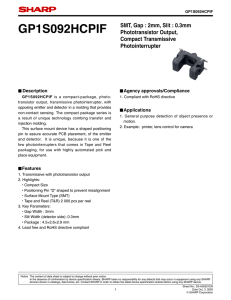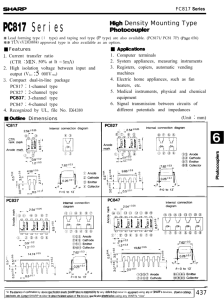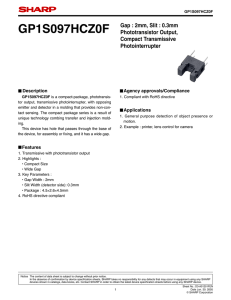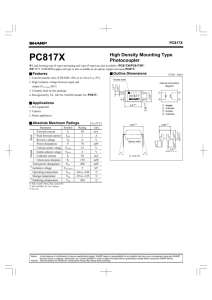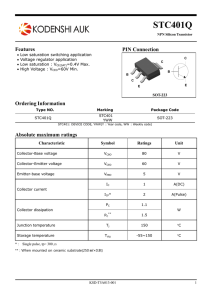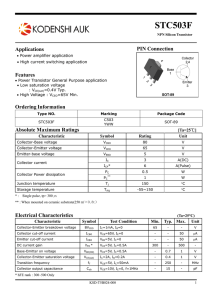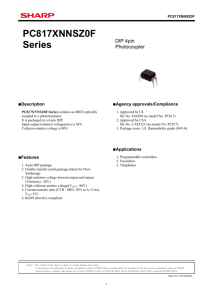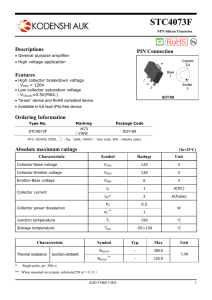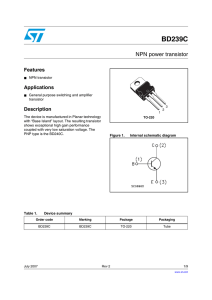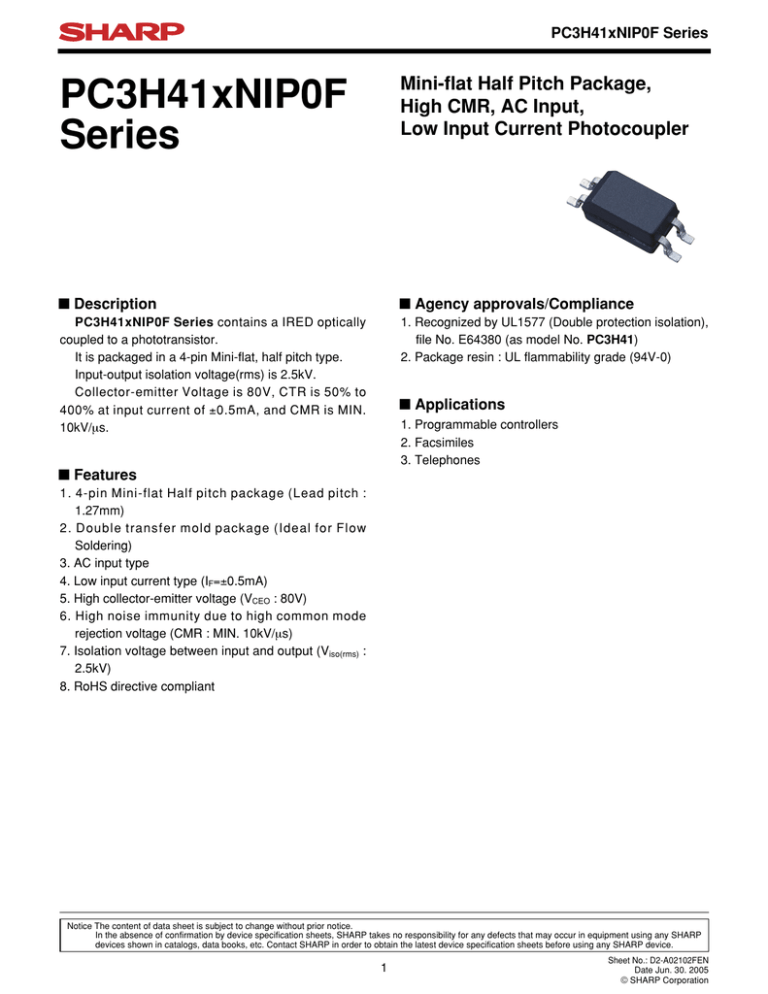
PC3H41xNIP0F Series
Mini-flat Half Pitch Package,
High CMR, AC Input,
Low Input Current Photocoupler
PC3H41xNIP0F
Series
∗
4-channel package type is also available.
(model No. )
■ Description
■ Agency approvals/Compliance
PC3H41xNIP0F Series contains a IRED optically
coupled to a phototransistor.
It is packaged in a 4-pin Mini-flat, half pitch type.
Input-output isolation voltage(rms) is 2.5kV.
Collector-emitter Voltage is 80V, CTR is 50% to
400% at input current of ±0.5mA, and CMR is MIN.
10kV/µs.
1. Recognized by UL1577 (Double protection isolation),
file No. E64380 (as model No. PC3H41)
2. Package resin : UL flammability grade (94V-0)
■ Applications
1. Programmable controllers
2. Facsimiles
3. Telephones
■ Features
1. 4-pin Mini-flat Half pitch package (Lead pitch :
1.27mm)
2. Double transfer mold package (Ideal for Flow
Soldering)
3. AC input type
4. Low input current type (IF=±0.5mA)
5. High collector-emitter voltage (VCEO : 80V)
6. High noise immunity due to high common mode
rejection voltage (CMR : MIN. 10kV/µs)
7. Isolation voltage between input and output (Viso(rms) :
2.5kV)
8. RoHS directive compliant
Notice The content of data sheet is subject to change without prior notice.
In the absence of confirmation by device specification sheets, SHARP takes no responsibility for any defects that may occur in equipment using any SHARP
devices shown in catalogs, data books, etc. Contact SHARP in order to obtain the latest device specification sheets before using any SHARP device.
1
Sheet No.: D2-A02102FEN
Date Jun. 30. 2005
© SHARP Corporation
PC3H41xNIP0F Series
■ Internal Connection Diagram
1
1
4
2
3
2
3
■ Outline Dimensions
(Unit : mm)
Date code
1
4
H41
2
4.4±0.2
3
0.4±0.1
1.27±0.25
2.6±0.3
Rank mark
SHARP mark "S"
Primary side mark
4
Anode /Cathode
Cathode / Anode
Emitter
Collector
5.3±0.3
Epoxy resin
0.5+0.4
−0.2
0.1±0.1 2.0±0.2
0.2±0.05
(1.7)
7.0+0.2
−0.7
*( ) : Reference dimensions
Product mass : approx. 0.05g
Plating material : SnCu (Cu : TYP. 2%)
Sheet No.: D2-A02102FEN
2
PC3H41xNIP0F Series
Date code (2 digit)
A.D.
1990
1991
1992
1993
1994
1995
1996
1997
1998
1999
2000
2001
1st digit
Year of production
A.D
Mark
2002
A
2003
B
2004
C
2005
D
2006
E
2007
F
2008
H
2009
J
2010
K
2011
L
2012
M
··
N
·
Mark
P
R
S
T
U
V
W
X
A
B
C
··
·
2nd digit
Month of production
Month
Mark
January
1
February
2
March
3
April
4
May
5
June
6
July
7
August
8
September
9
October
O
November
N
December
D
repeats in a 20 year cycle
Country of origin
Japan
Rank mark
Refer to the Model Line-up table
Sheet No.: D2-A02102FEN
3
PC3H41xNIP0F Series
■ Absolute Maximum Ratings
Output
Input
Parameter
Symbol
IF
Forward current
*1
Peak forward current
IFM
Power dissipation
P
Collector-emitter voltage VCEO
Emitter-collector voltage VECO
Collector current
IC
Collector power dissipation
PC
Total power dissipation
Ptot
Operating temperature
Topr
Storage temperature
Tstg
*2
Isolation voltage
Viso (rms)
*3
Soldering temperature
Tsol
Rating
±10
±200
15
80
6
50
150
170
−30 to +100
−40 to +125
2.5
260
(Ta=25˚C)
Unit
mA
mA
mW
V
V
mA
mW
mW
˚C
˚C
kV
˚C
*1 Pulse width≤100µs, Duty ratio : 0.001
*2 40 to 60%RH, AC for 1 minute, f=60Hz
*3 For 10s
■ Electro-optical Characteristics
Input
Output
Transfer
characteristics
Symbol
Parameter
VF
Forward voltage
Terminal capacitance
Ct
Collector dark current
ICEO
Collector-emitter breakdown voltage BVCEO
Emitter-collector breakdown voltage BVECO
Collector current
IC
Collector-emitter saturation voltage VCE (sat)
Isolation resistance
RISO
Floating capacitance
Cf
Rise time
tr
Response time
Fall time
tf
Common mode rejection voltage
CMR
Conditions
IF=±10mA
V=0, f=1kHz
VCE=50V, IF=0
IC=0.1mA, IF=0
IE=10µA, IF=0
IF=±0.5mA, VCE=5V
IF=±10mA, IC=1mA
DC500V, 40 to 60%RH
V=0, f=1MHz
VCE=2V, IC=2mA, RL=100Ω
Ta=25˚C, RL=470Ω, VCM=1.5kV(peak),
IF=0, VCC=9V, Vnp=100mV
MIN.
−
−
−
80
6
0.25
−
5×1010
−
−
−
TYP.
1.2
30
−
−
−
−
−
1×1011
0.6
4
3
MAX.
1.4
250
100
−
−
2.0
0.2
−
1.0
18
18
(Ta=25˚C)
Unit
V
pF
nA
V
V
mA
V
Ω
pF
µs
µs
10
−
−
kV/µs
Sheet No.: D2-A02102FEN
4
PC3H41xNIP0F Series
■ Model Line-up
Taping
3 000pcs/reel
PC3H410NIP0F
Model No.
PC3H411NIP0F
Package
Rank mark
IC [mA]
(IF=±0.5mA, VCE=5V, Ta=25˚C)
with or without
A
0.25 to 2.0
0.5 to 1.5
Please contact a local SHARP sales representative to inquire about production status.
Sheet No.: D2-A02102FEN
5
PC3H41xNIP0F Series
Fig.1 Test Circuit for Common Mode Rejection Voltage
(dV/dt)
VCM
RL
1)
VCC
Vnp
VCM : High wave
pulse
RL=470Ω
VCC=9V
VCM
Vnp
Vcp
VO
(Vcp Nearly = dV/dt×Cf×RL)
1) Vcp : Voltage which is generated by displacement current in floating
capacitance between primary and secondary side.
Fig.3 Diode Power Dissipation vs. Ambient
Temperature
Fig.2 Forward Current vs. Ambient
Temperature
Diode power dissipation P (mW)
Forward current IF (mA)
15
10
5
0
−30
0
25
50
75
100
15
10
5
0
−30
125
0
Fig.4 Collector Power Dissipation vs.
Ambient Temperature
75
100
125
250
Total power dissipation Ptot (mW)
Collector power dissipation PC (mW)
50
Fig.5 Total Power Dissipation vs. Ambient
Temperature
250
200
150
100
50
0
−30
25
Ambient temperature Ta (˚C)
Ambient temperature Ta (˚C)
0
25
50
75
100
200
170
150
100
50
0
−30
125
Ambient temperature Ta (˚C)
0
25
50
75
100
125
Ambient temperature Ta (˚C)
Sheet No.: D2-A02102FEN
6
PC3H41xNIP0F Series
Fig.7 Forward Current vs. Forward Voltage
Fig.6 Peak Forward Current vs. Duty Ratio
Forward current IF (mA)
1 000
Peak forward current IFM (mA)
100
Pulse width≤100µs
Ta=25˚C
100
10
10−3
10−2
10
Ta=25˚C
Ta=100˚C
Ta=0˚C
Ta=75˚C
1
Ta=−25˚C
Ta=50˚C
0.1
10−1
1
0
0.5
Duty ratio
1
1.5
2
Forward voltage VF (V)
Fig.8 Current Transfer Ratio vs. Forward
Current
Fig.9 Collector Current vs. Collector-emitter
Voltage
40
600
VCE=5V
Ta=25˚C
Ta=25˚C
PC (MAX.)
Collector current IC (mA)
Current transfer ratio CTR (%)
500
400
300
200
30
IF=7mA
20
IF=5mA
IF=3mA
IF=2mA
10
100
0
0.1
0
1
0
10
2
4
6
8
10
Collector-emitter voltage VCE (V)
Forward current IF (mA)
Fig.10 Relative Current Transfer Ratio vs.
Ambient Temperature
Fig.11 Collector - emitter Saturation Voltage
vs. Ambient Temperature
Collector-emitter saturation voltage VCE (sat) (V)
150
Relative current transfer ratio (%)
IF=0.5mA
IF=1mA
VCE=5V
IF=0.5mA
100
50
0
−30 −20 −10 0 10 20 30 40 50 60 70 80 90 100
Ambient temperature Ta (˚C)
0.16
IF=10mA
IC=1mA
0.14
0.12
0.1
0.08
0.06
0.04
0.02
0
−30 −20 −10 0 10 20 30 40 50 60 70 80 90 100
Ambient temperature Ta (˚C)
Sheet No.: D2-A02102FEN
7
PC3H41xNIP0F Series
Fig.12 Collector Dark Current vs. Ambient
Temperature
100
VCE=50V
VCE=2V, IC=2mA
10−6
10−7
Responce time (µs)
Collector dark current ICEO (A)
10−5
Fig.13 Response Time vs. Load Resistance
(active region)
10−8
10−9
tr
tf
10
td
ts
10−10
10−11
−30 −20 −10 0 10 20 30 40 50 60 70 80 90 100
1
0.1
1
Ambient temperature Ta (˚C)
Load resistance RL (kΩ)
Fig.14 Response Time vs. Load Resistance
(saturation region)
1 000
Fig.15 Test Circuit for Response Time
Vcc=5V, IF=1mA, Ta=25˚C
VCC
RL
RD
tf
Responce time (µs)
10
Output Input
Output
Input
ts
100
10%
VCE
ts
tf
td
tr
10
tr
Please refer to the conditions in Fig.13 and Fig.14
td
1
90%
1
10
100
Load resistance RL (kΩ)
Fig.16 Frequency Response
Fig.17 Collector-emitter Saturation Voltage
vs. Forward Current
VCE=2V
IC=2mA
Ta=25˚C
0
Voltage gain AV (dB)
Collector-emitter saturation voltage VCE (sat) (V)
5
RL=10kΩ
−5
1kΩ
−10
100Ω
−15
−20
−25
0.1
1
10
100
1 000
5
IC=7mA
4
IC=3mA
IC=2mA
3
IC=1mA
IC=0.5mA
2
1
0
0
Frequency f (kHz)
Ta=25˚C
IC=5mA
2
4
6
8
10
Forward current IF (mA)
Remarks : Please be aware that all data in the graph are just for reference and not for guarantee.
Sheet No.: D2-A02102FEN
8
PC3H41xNIP0F Series
■ Design Considerations
● Design guide
While operating at IF<0.5mA, CTR variation may increase.
Please make design considering this fact.
In case that some sudden big noise caused by voltage variation is provided between primary and secondary
terminals of photocoupler some current caused by it is floating capacitance may be generated and result in
false operation since current may go through IRED or current may change.
If the photocoupler may be used under the circumstances where noise will be generated we recommend to
use the bypass capacitors at the both ends of IRED.
This product is not designed against irradiation and incorporates non-coherent IRED.
● Degradation
In general, the emission of the IRED used in photocouplers will degrade over time.
In the case of long term operation, please take the general IRED degradation (50% degradation over 5
years) into the design consideration.
● Recommended Foot Print (reference)
0.8
1.27
6.3
1.5
(Unit : mm)
✩ For additional design assistance, please review our corresponding Optoelectronic Application Notes.
Sheet No.: D2-A02102FEN
9
PC3H41xNIP0F Series
■ Manufacturing Guidelines
● Soldering Method
Reflow Soldering:
Reflow soldering should follow the temperature profile shown below.
Soldering should not exceed the curve of temperature profile and time.
Please don't solder more than twice.
(˚C)
300
Terminal : 260˚C peak
( package surface : 250˚C peak)
200
Reflow
220˚C or more, 60s or less
Preheat
150 to 180˚C, 120s or less
100
0
0
1
2
3
4
(min)
Flow Soldering :
Due to SHARP's double transfer mold construction submersion in flow solder bath is allowed under the below
listed guidelines.
Flow soldering should be completed below 260˚C and within 10s.
Preheating is within the bounds of 100 to 150˚C and 30 to 80s.
Please don't solder more than twice.
Hand soldering
Hand soldering should be completed within 3s when the point of solder iron is below 400˚C.
Please don't solder more than twice.
Other notices
Please test the soldering method in actual condition and make sure the soldering works fine, since the impact
on the junction between the device and PCB varies depending on the tooling and soldering conditions.
Sheet No.: D2-A02102FEN
10
PC3H41xNIP0F Series
● Cleaning instructions
Solvent cleaning:
Solvent temperature should be 45˚C or below Immersion time should be 3 minutes or less
Ultrasonic cleaning:
The impact on the device varies depending on the size of the cleaning bath, ultrasonic output, cleaning time,
size of PCB and mounting method of the device.
Therefore, please make sure the device withstands the ultrasonic cleaning in actual conditions in advance of
mass production.
Recommended solvent materials:
Ethyl alcohol, Methyl alcohol and Isopropyl alcohol
In case the other type of solvent materials are intended to be used, please make sure they work fine in
actual using conditions since some materials may erode the packaging resin.
● Presence of ODC
This product shall not contain the following materials.
And they are not used in the production process for this product.
Regulation substances : CFCs, Halon, Carbon tetrachloride, 1.1.1-Trichloroethane (Methylchloroform)
Specific brominated flame retardants such as the PBBOs and PBBs are not used in this product at all.
This product shall not contain the following materials banned in the RoHS Directive (2002/95/EC).
•Lead, Mercury, Cadmium, Hexavalent chromium, Polybrominated biphenyls (PBB), Polybrominated
diphenyl ethers (PBDE).
Sheet No.: D2-A02102FEN
11
PC3H41xNIP0F Series
■ Package specification
● Tape and Reel package
Package materials
Carrier tape : PS
Cover tape : PET (three layer system)
Reel : PS
Carrier tape structure and Dimensions
F
G
D
J
I
H
L
K
Dimensions List
A
B
12.0±0.3
5.5±0.1
H
I
±0.1
7.5
0.3±0.05
C
1.75±0.1
J
2.3±0.1
D
8.0±0.1
K
3.1±0.1
E
2.0±0.1
L
+0.1
φ1.6−0
5˚
MAX
.
H
A
B
C
E
(Unit : mm)
F
G
+0.1
4.0±0.1
φ1.5−0
Reel structure and Dimensions
e
d
c
g
Dimensions List
a
b
330
13.5±1.5
e
f
±1.0
23
2.0±0.5
f
a
b
(Unit : mm)
c
d
100±1.0
13±0.5
g
2.0±0.5
Direction of product insertion
Pull-out direction
[Packing : 3 000pcs/reel]
Sheet No.: D2-A02102FEN
12
PC3H41xNIP0F Series
■ Important Notices
with equipment that requires higher reliability such as:
--- Transportation control and safety equipment (i.e.,
aircraft, trains, automobiles, etc.)
--- Traffic signals
--- Gas leakage sensor breakers
--- Alarm equipment
--- Various safety devices, etc.
(iii) SHARP devices shall not be used for or in connection with equipment that requires an extremely high level of reliability and safety such as:
--- Space applications
--- Telecommunication equipment [trunk lines]
--- Nuclear power control equipment
--- Medical and other life support equipment (e.g.,
scuba).
· The circuit application examples in this publication are
provided to explain representative applications of
SHARP devices and are not intended to guarantee any
circuit design or license any intellectual property rights.
SHARP takes no responsibility for any problems related to any intellectual property right of a third party resulting from the use of SHARP's devices.
· Contact SHARP in order to obtain the latest device
specification sheets before using any SHARP device.
SHARP reserves the right to make changes in the specifications, characteristics, data, materials, structure,
and other contents described herein at any time without
notice in order to improve design or reliability. Manufacturing locations are also subject to change without notice.
· If the SHARP devices listed in this publication fall within the scope of strategic products described in the Foreign Exchange and Foreign Trade Law of Japan, it is
necessary to obtain approval to export such SHARP devices.
· Observe the following points when using any devices
in this publication. SHARP takes no responsibility for
damage caused by improper use of the devices which
does not meet the conditions and absolute maximum
ratings to be used specified in the relevant specification
sheet nor meet the following conditions:
(i) The devices in this publication are designed for use
in general electronic equipment designs such as:
--- Personal computers
--- Office automation equipment
--- Telecommunication equipment [terminal]
--- Test and measurement equipment
--- Industrial control
--- Audio visual equipment
--- Consumer electronics
(ii) Measures such as fail-safe function and redundant
design should be taken to ensure reliability and safety
when SHARP devices are used for or in connection
· This publication is the proprietary product of SHARP
and is copyrighted, with all rights reserved. Under the
copyright laws, no part of this publication may be reproduced or transmitted in any form or by any means, electronic or mechanical, for any purpose, in whole or in
part, without the express written permission of SHARP.
Express written permission is also required before any
use of this publication may be made by a third party.
· Contact and consult with a SHARP representative if
there are any questions about the contents of this publication.
[E211]
Sheet No.: D2-A02102FEN
13

